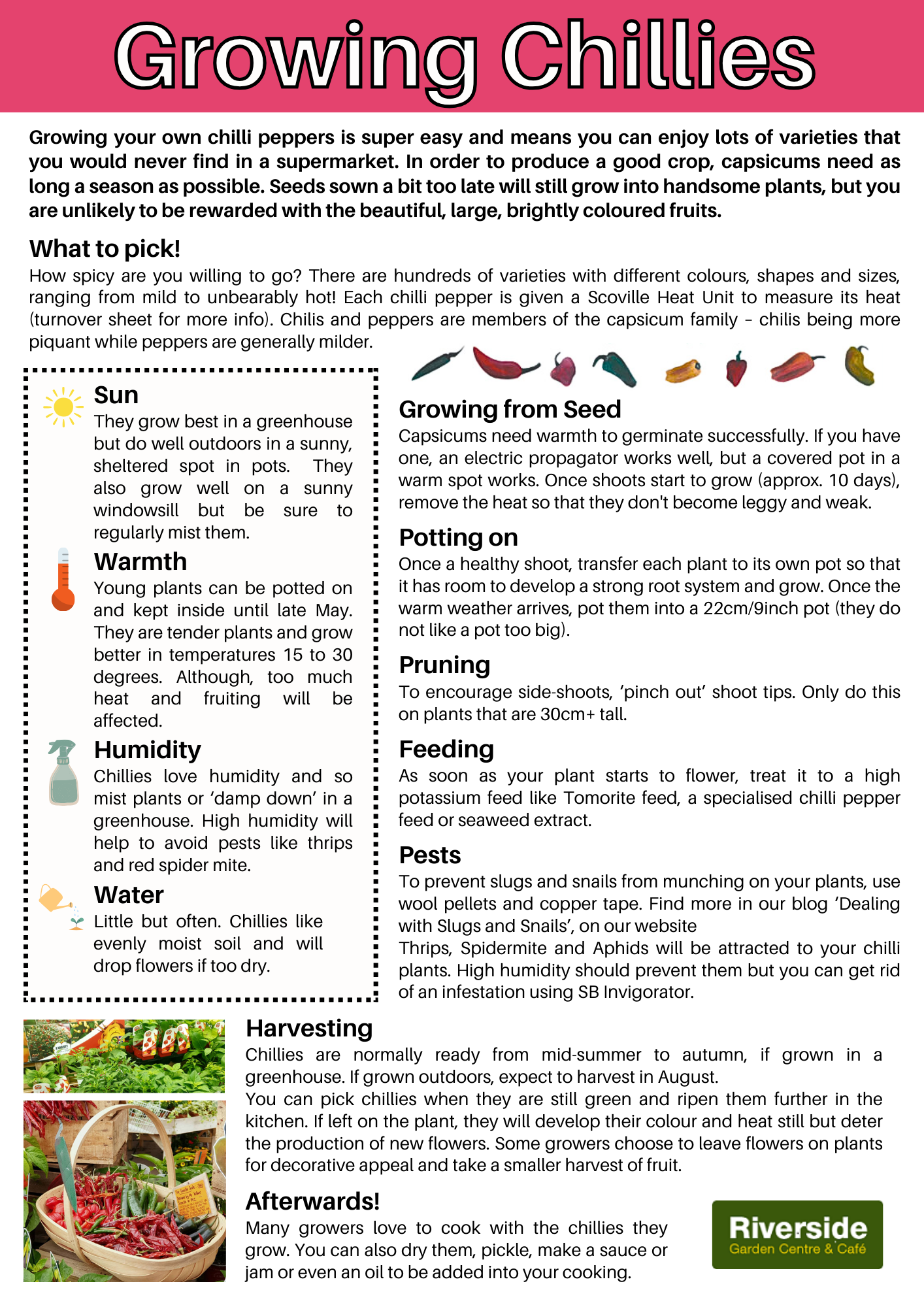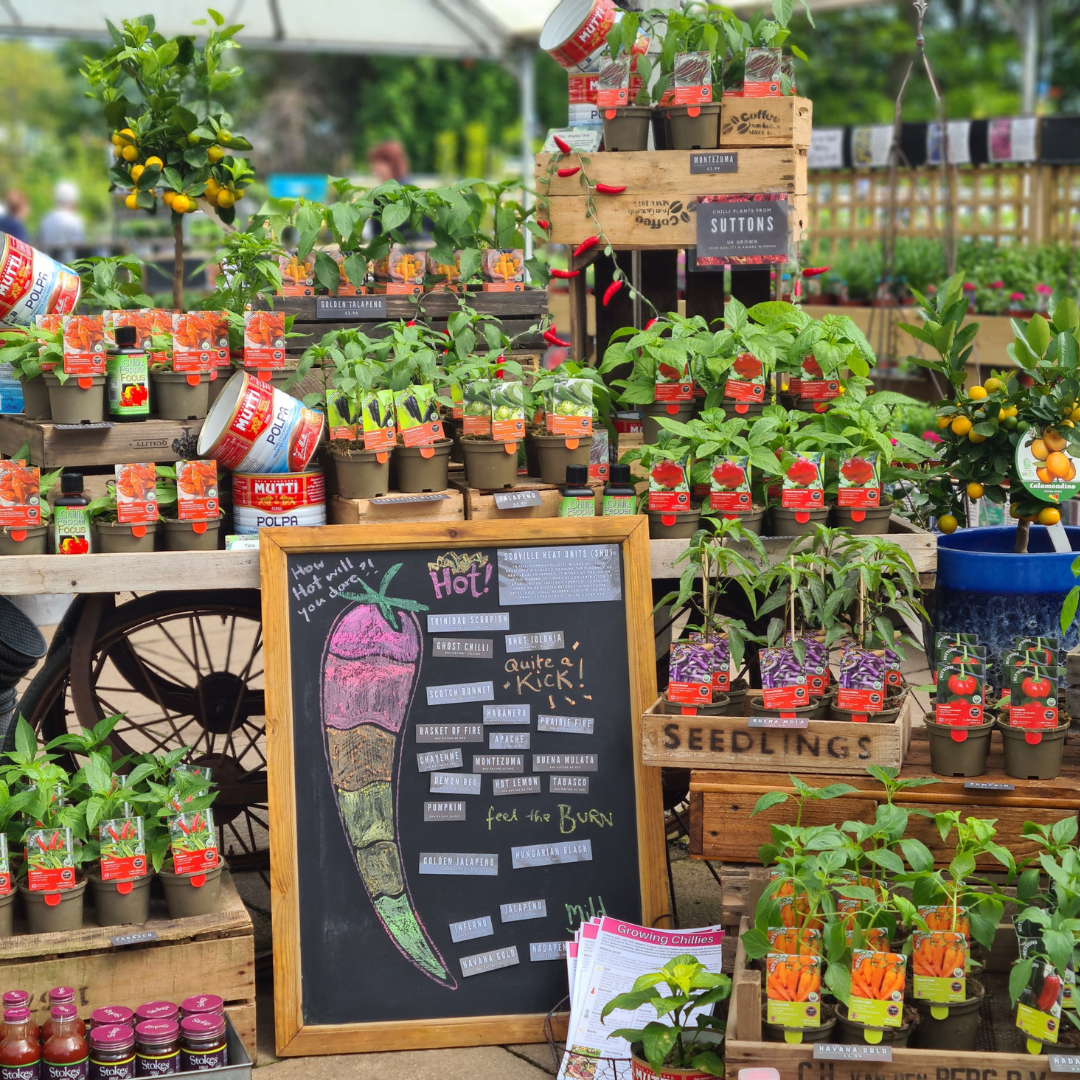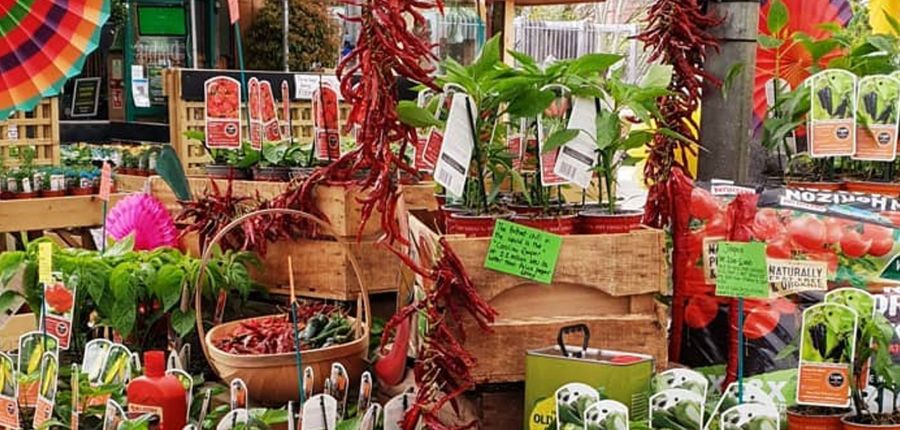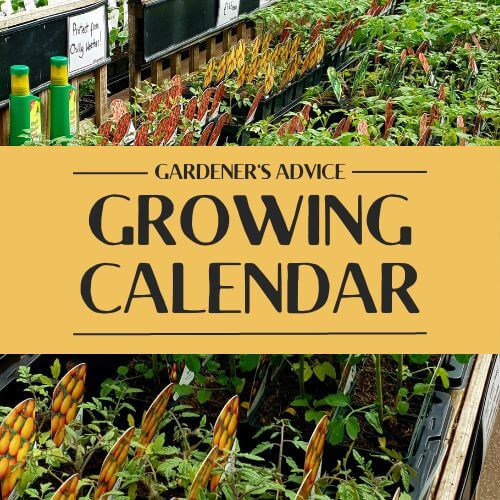Growing Chilli Peppers
Posted By: Category: Plant Care, Seasonal Advice
.jpg)
Download this guide as a pdf or pick on up from Riverside!
Growing your own chilli peppers is super easy and means you can enjoy lots of varieties that you would never find in a supermarket. In order to produce a good crop, capsicums need as long a season as possible. Seeds sown a bit too late will still grow into handsome plants, but you are unlikely to be rewarded with the beautiful, large, brightly coloured fruits.
What to pick!
How spicy are you willing to go? There are hundreds of varieties with different colours, shapes and sizes, ranging from mild to unbearably hot! Each chilli pepper is given a Scoville Heat Unit to measure its heat (more info below). Chilis and peppers are members of the capsicum family – chilis being more piquant while peppers are generally milder.

.png)
The most important:
Sun - They grow best in a greenhouse but do well outdoors in a sunny, sheltered spot in pots. They also grow well on a sunny windowsill but be sure to regularly mist them.
Warmth - Young plants can be potted on and kept inside until late May. They are tender plants and grow better in temperatures 15 to 30 degrees. Although, too much heat and fruiting will be affected.
Humidity - Chillies love humidity and so mist plants or ‘damp down’ in a greenhouse. High humidity will help to avoid pests like thrips and red spider mite.
Water - Little but often. Chillies like evenly moist soil and will drop flowers if too dry.
Growing from Seed
Capsicums need warmth to germinate successfully. If you have one, an electric propagator works well, but a covered pot in a warm spot works. Once shoots start to grow (approx. 10 days), remove the heat so that they don't become leggy and weak.
Potting on
Once a healthy shoot, transfer each plant to its own pot so that it has room to develop a strong root system and grow. Once the warm weather arrives, pot them into a 22cm/9inch pot (they do not like a pot too big).
Pruning
To encourage side-shoots, ‘pinch out’ shoot tips. Only do this on plants that are 30cm+ tall.
Feeding
As soon as your plant starts to flower, treat it to a high potassium feed like Tomorite feed, a specialised chilli pepper feed or seaweed extract.
.png)
.png)
Pests
To prevent slugs and snails from munching on your plants, use wool pellets and copper tape. Find more in our blog ‘Dealing with Slugs and Snails’, on our website
Thrips, Spidermite and Aphids will be attracted to your chilli plants. High humidity should prevent them but you can get rid of an infestation using SB Invigorator.
Harvesting
Chillies are normally ready from mid-summer to autumn, if grown in a greenhouse. If grown outdoors, expect to harvest in August.
You can pick chillies when they are still green and ripen them further in the kitchen. If left on the plant, they will develop their colour and heat still but deter the production of new flowers. Some growers choose to leave flowers on plants for decorative appeal and take a smaller harvest of fruit.
Afterwards!
Many growers love to cook with the chillies they grow. You can also dry them, pickle, make a sauce or jam or even an oil to be added into your cooking.
Scoville Heat Units (SHU)
In 1912, pharmacologist Wilbur Scoville developed a scale to measure the pungency or heat level in peppers. It works by measuring the the number of times the concentration of capsaicinoids (irritant chemical compound) needs to be diluted before it’s no longer detectable. Chilli peppers contain the main pungent capsaicinoid called capsaicin.
Bell Pepper - 0 | Jalapeño - 2,000 - 8,000 | Tabasco Pepper - 50,000 | Scotch Bonnet - 100,000 | Habarnero - 250,000 | Brut jobkia (Ghost Chilli) - 1 million | Trinidad Moruga Scorpion 1.2 million | Carolina Reaper 1.5 million | Dragons Breath 1.5 million - 2.5 million
Chilli Trivia:
- Chilli peppers are believed to have originated in Central or South America and were first cultivated in Mexico. European explorers would introduce chillis across Europe and South Asia as part of the 16th century Columbian Exchange.
- Chillies were first recorded in the UK in 1548
- The hottest part of a chilli is the white membrane that connects the seeds
- The ‘Aji Charapita’ from Peru is the most expensive chilli in the world - 1kg for $25,000.
- Medical uses include: Fighting Inflammation, Pain Relief, Clearing Congestion, Boosting Immunity, Preventing Stomach Ulcers, Endorphins and Dopamine Releasers, Antibacterial
- Chillies contain Vitamin A, B, and lots of C, Magnesium and Potassium
- 1 chilli has as much Vitamin C as 6 oranges!
- Spice up your love life by adding chillis to your diet. Chillis act as a vasodilator- lowering inhibitions, relaxing arteries and increasing bloodflow to your heart and other organs...
- Combat the Burn! Water and beer are the worse way to make the heat pass, as they transfer the spice further into your taste buds. Instead, try holding milk or yogurt in your mouth for as long as possible, or eat sugar, which reduces the heat sensation.
- Birds, snails and slugs are immune to the heat of chillies! Only mammals feel it’s negative effects
- In Africa, chilli powder is used as a defence for crops from elephants







